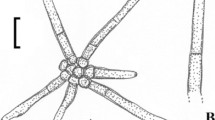Abstract
A new species of mycelium-forming yeast,Endomycopsis platypodis Baker et van Rij is described. It occurs as an auxiliary ambrosia fungus of the wood-boring ambrosia beetlePlatypus cylindrus Fab. (Col. Platypodidae) and is the first fungus to become established in new tunnels where it forms a sparse irregular lining. Later a palisade-formingSporothrix becomes the dominant fungus in a mixed ambrosial flora.
E. platypodis, which is apparently homothallic, assimilates nitrate and weakly ferments glucose. The asci typically contain 4 hat-shaped ascospores. Assimilation reactions and morphology are described and the affinities of the new species are discussed.
Similar content being viewed by others
References
Baker, J. M. 1960.In Ambrosia beetle research in West Africa. Rept. 7th Commonwealth Entomol. Conf. 1960, p. 94.
Baker, J. M. 1963. Ambrosia beetles and their fungi with particular reference toPlatypus cylindrus Fab. p. 232–265.In Symbiotic associations, 13th Symp. Soc. Gen. Microbiol. University Press, Cambridge.
Batra, L. R. 1963. Contributions to our knowledge of ambrosia fungi. II.Endomycopsis fasciculata nom. nov. (Ascomycetes) Am. J. Botany50: 481–487.
Batra, L. R. andFrancke-Grosmann, H. 1961. Contributions to our knowledge of ambrosia fungi. I.Ascoidea hylecoeti sp. nov. (Ascomycetes). Am. J. Botany48: 453–456.
Beck, O. 1922. Eine neue Endomyces-Art.Endomyces bisporus. Ann. mycol. Berl.20: 219–227.
Francke-Grosmann, H. 1956. Hautdrüsen als Träger der Pilzsymbiose bei Ambrosiakäfern. Z. Morphol. Ökol. Tiere45: 275–308.
Grosmann, H. 1930. Beiträge zur Kenntnis der Lebensgemeinschaft zwischen Borkenkäfern und Pilzen. Z. Parasitenk.3: 56–102.
Lodder, J. andKreger-van Rij, N. J. W. 1952. The Yeasts. North Holland Publishing Co., Amsterdam.
Mathiesen-Käärik, A. 1953. Eine Übersicht über die gewöhnlichsten mit Borkenkäfern assoziierten Bläuepilze in Schweden und einige für Schweden neue Bläuepilze. Medd. Statens Skogsforskningsinst. 43.
Siemaszko, W. 1939. Fungi associated with bark-beetles in Poland. Planta Polon.7: (3).
Verrall, A. F. 1943. Fungi associated with certain ambrosia beetles. J. Agr. Res.66: 135–144.
Webb, S. 1945. Australian ambrosia fungi. Proc. Roy. Soc. Victoria, [N.S.]57: 57–79.
Wickerham, L. J. 1951. Taxonomy of yeasts. U.S. Dept. Agr. Tech. Bull. 1029.
Wickerham, L. J. andBurton, K. A. 1962. Phylogeny and biochemistry of the genusHansenula. Bacteriol. Rev.26: 382–397.
Author information
Authors and Affiliations
Rights and permissions
About this article
Cite this article
Baker, J.M., Kreger-van Rij, N.J.W. Endomycopsis platypodis sp.n. (Ascomycetes): an auxiliary ambrosia fungus ofPlatypus cylindrus Fab. (Col. Platypodidae). Antonie van Leeuwenhoek 30, 433–441 (1964). https://doi.org/10.1007/BF02046757
Received:
Issue Date:
DOI: https://doi.org/10.1007/BF02046757




